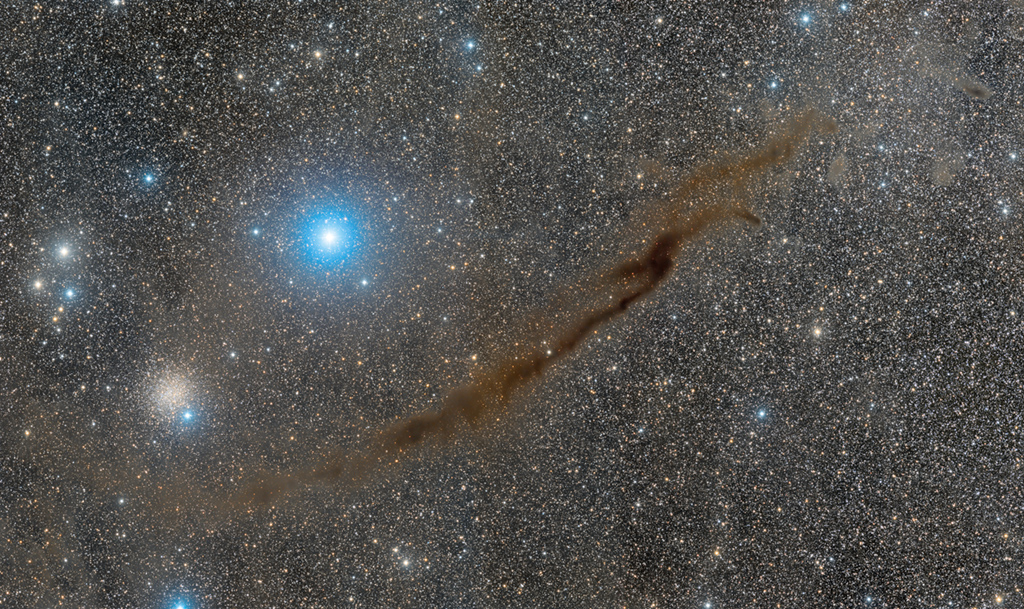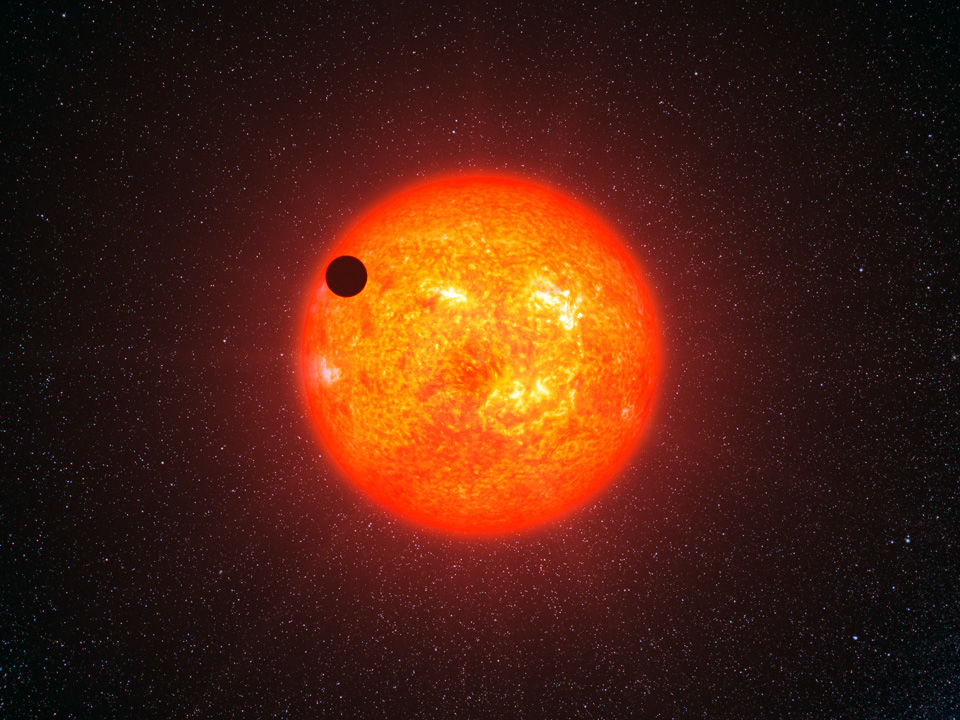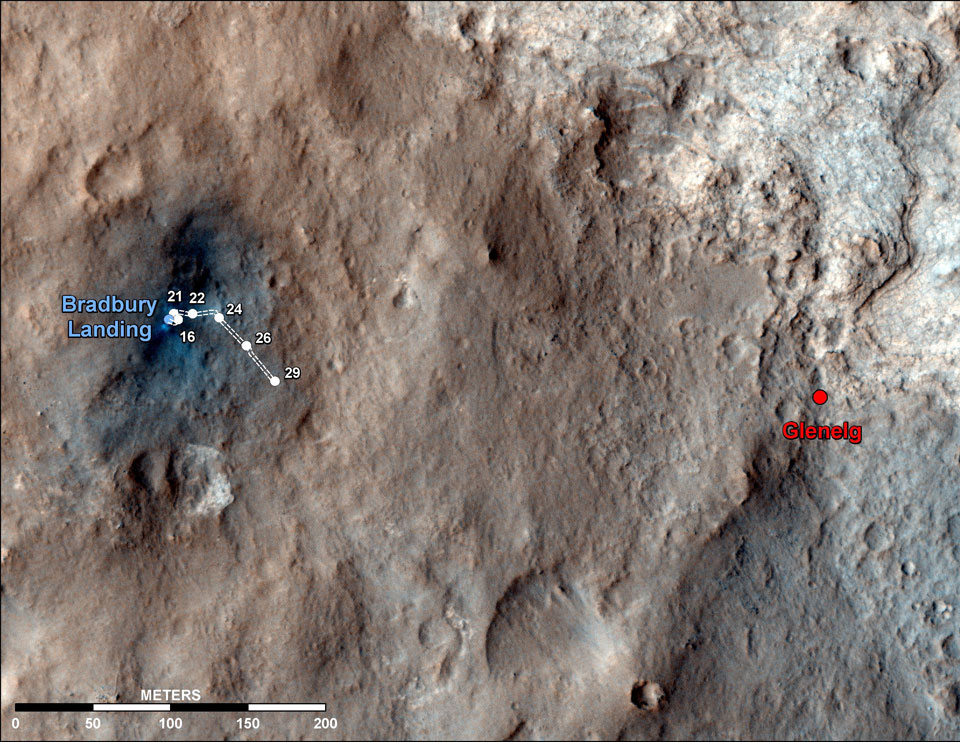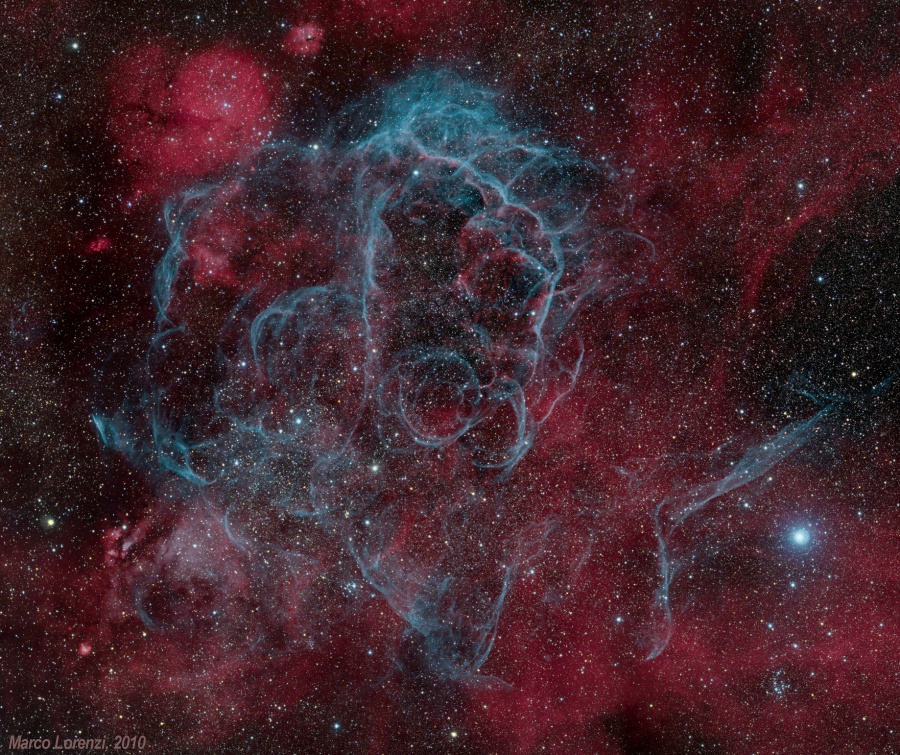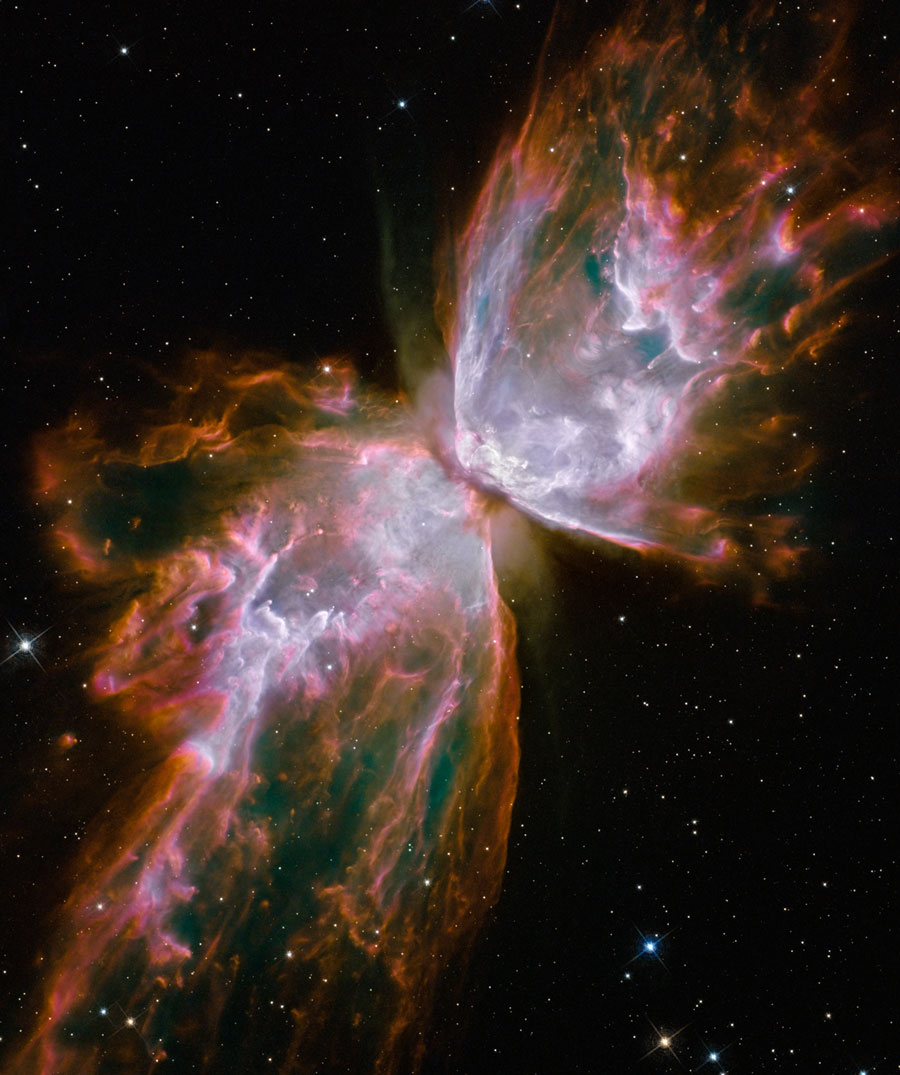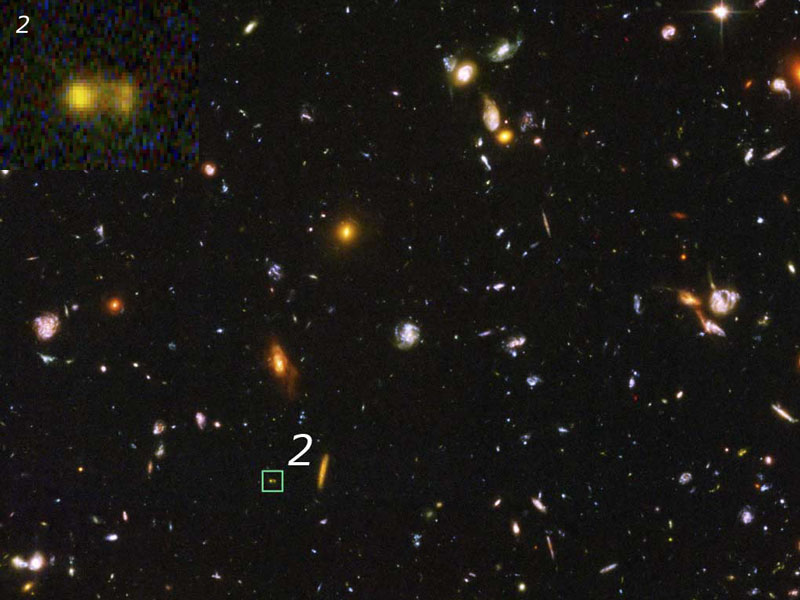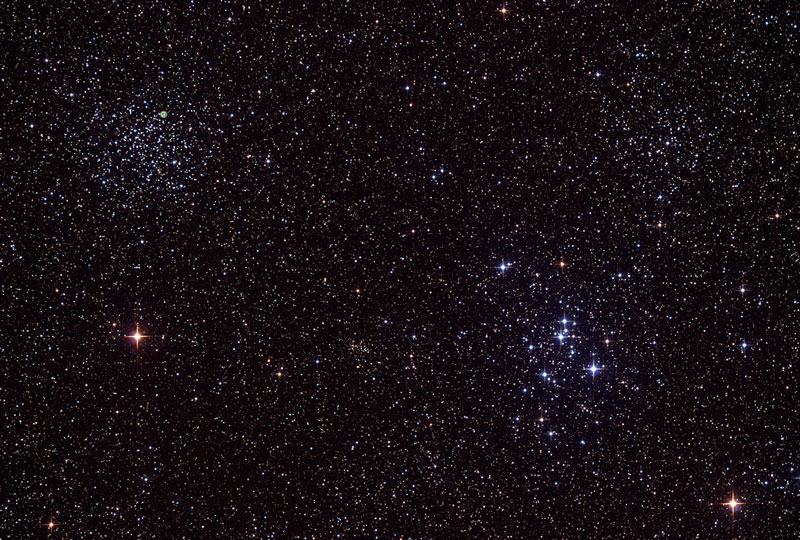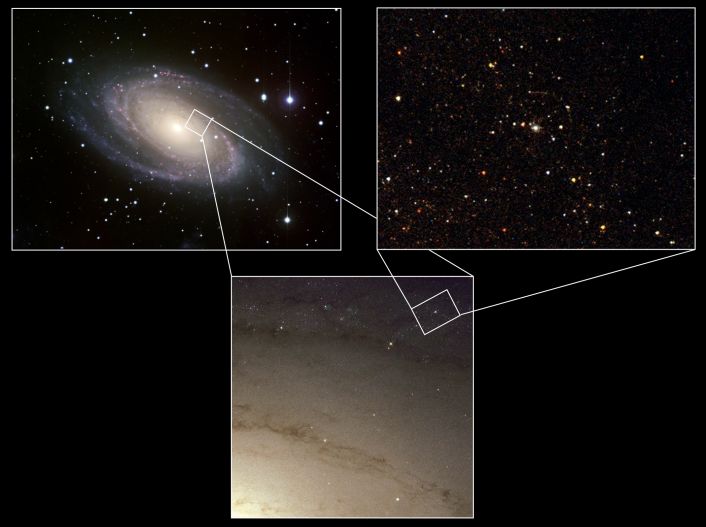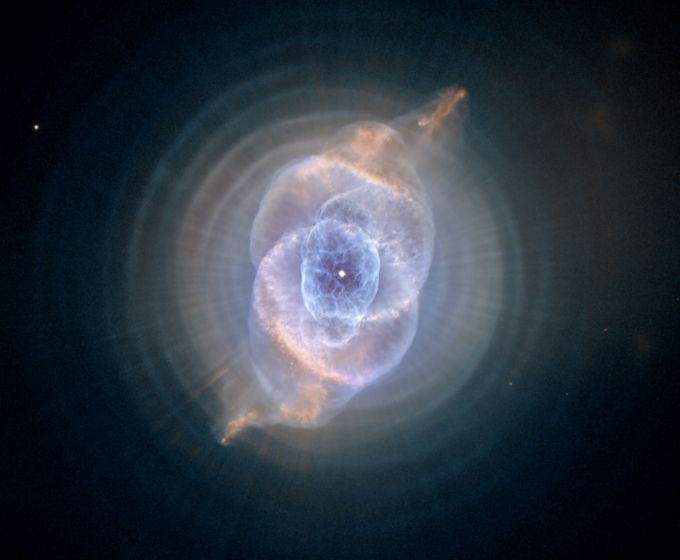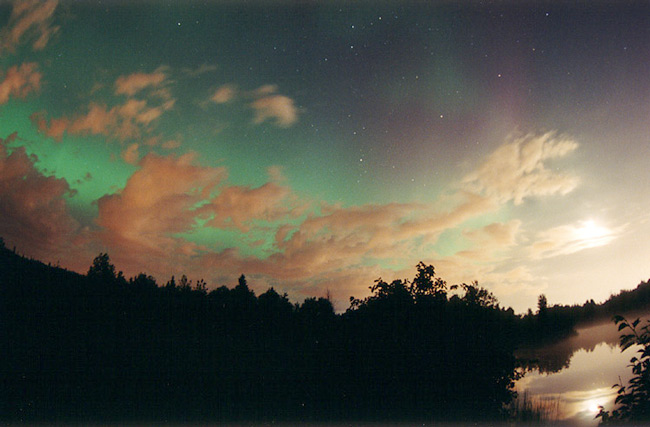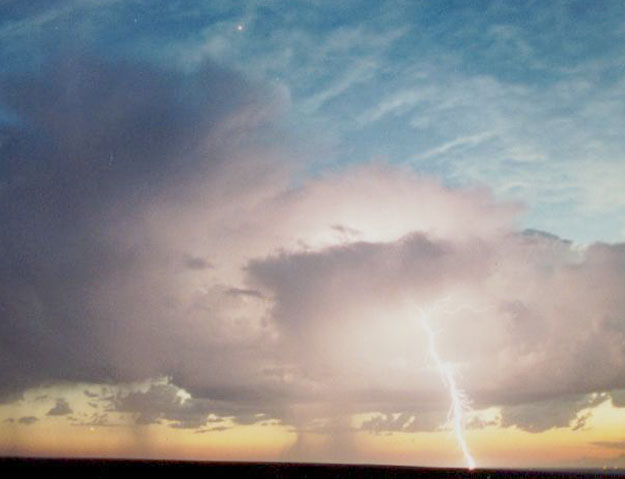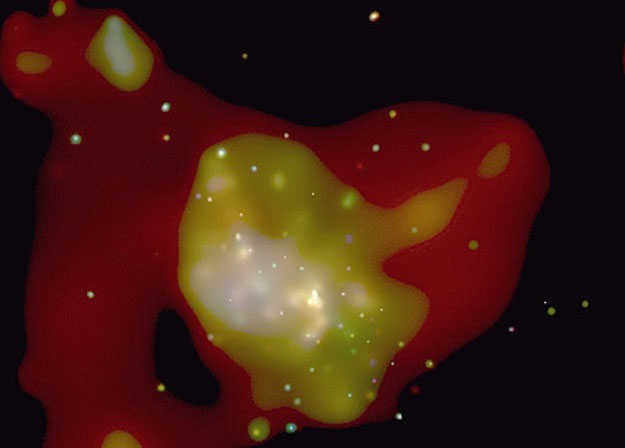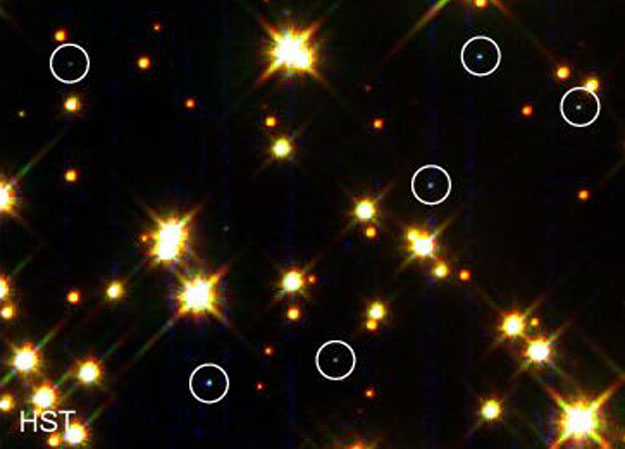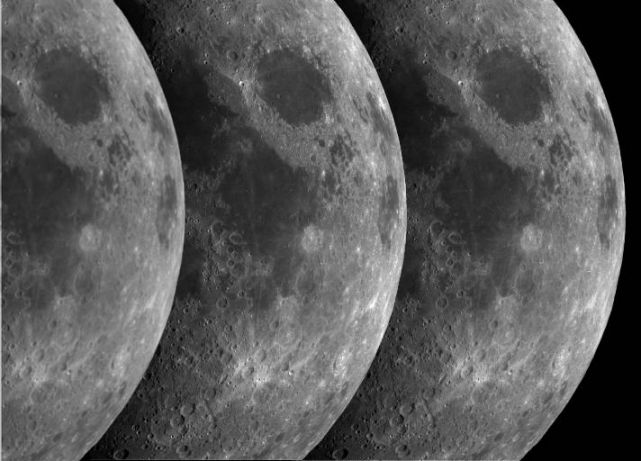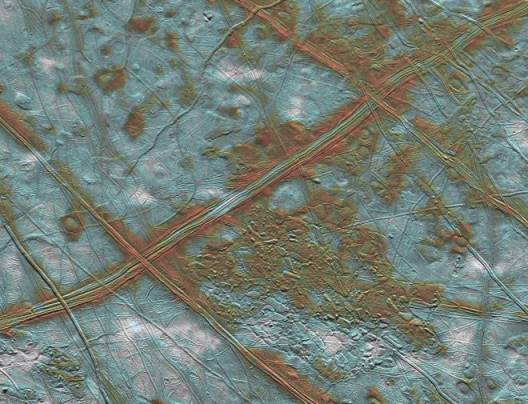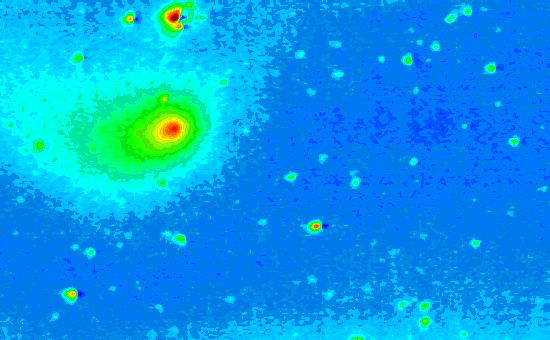| << Previous | Index | Next >> |
2015 The delightful Dark Doodad Nebula drifts through southern skies, a tantalizing target for binoculars in the constellation Musca, The Fly. The dusty cosmic cloud is seen against rich starfields just south of the prominent Coalsack Nebula and the Southern Cross. Stretching for about 3 degrees across this scene the Dark Doodad is punctuated at its southern tip (lower left) by globular star cluster NGC 4372. Of course NGC 4372 roams the halo of our Milky Way Galaxy, a background object some 20,000 light-years away and only by chance along our line-of-sight to the Dark Doodad. The Dark Doodad's well defined silhouette belongs to the Musca molecular cloud, but its better known alliterative moniker was first coined by astro-imager and writer Dennis di Cicco in 1986 while observing Comet Halley from the Australian outback. The Dark Doodad is around 700 light-years distant and over 30 light-years long.
2014 It is not only one of the largest structures known -- it is our home. The just-identified Laniakea Supercluster of galaxies contains thousands of galaxies that includes our Milky Way Galaxy, the Local Group of galaxies, and the entire nearby Virgo Cluster of Galaxies. The colossal supercluster is shown in the above computer-generated visualization, where green areas are rich with white-dot galaxies and white lines indicate motion towards the supercluster center. An outline of Laniakea is given in orange, while the blue dot shows our location. Outside the orange line, galaxies flow into other galactic concentrations. The Laniakea Supercluster spans about 500 million light years and contains about 100,000 times the mass of our Milky Way Galaxy. The discoverers of Laniakea gave it a name that means "immense heaven" in Hawaiian.
2013 Might this distant planet hold water? Actually, given how close Gliese 1214b is to its parent star, any water, if it exists, would surely be in the form of steam. In the above artist's illustration, the super-Earth Gliese 1214b is imagined passing in front of its parent star, creating a mini-eclipse that alerted humanity to its presence. Gliese 1214b, also designated GJ 1214b, has been designated a super-Earth because it is larger than the Earth but smaller a planet like Neptune. The entire Gliese 1214 planetary system is of the closest known systems to our Sun, located only 42 light years away. The parent star, Gliese 1214 is a slightly smaller and cooler version of our Sun. Recent observations from the Subaru telescope in Hawaii found very little scattering of blue light from the parent star by the planet. This appears most consistent with a planet that has a watery atmosphere -- although it is still possible that the super-Earth has clouds so thick that little of any color of light was scattered. Detecting water on exoplanets is important partly because most lifeforms on Earth need water to survive.
2012 Curiosity is on the move across Mars -- but where is it going? The car-sized rover's path after 29 Martian days on the surface is shown on the above map. Curiosity is still almost 300 meters from its first major destination, though, a meeting of different types of terrain called Glenelg and visible on the image right. It may take Curiosity two months or so to get to Glenelg as it stops to inspect interesting rocks or landscape features along the way. The above image was taken about one week ago from high up by the HiRISE camera onboard the robotic Mars Reconnaissance Orbiter.
2011 This dramatic time-lapse photo traces a 20 minute long, late evening rollback of the lighted Mobile Service Tower at Cape Canaveral Air Force Station Launch Complex 17. Twin spacecraft are snug inside the 13 story tall Delta 2 rocket poised for launch. The duo will journey to the Moon on NASA's Gravity Recovery and Interior Laboratory mission, GRAIL, using precision formation flying to map the Moon's gravity field. The scene was captured prior to the first launch attempt, canceled due to upper level winds, on September 8. Further launch opportunities for GRAIL begin this morning, September 10. The GRAIL launch is the last one planned from Complex 17 on Cape Canaveral's oldest still active pad, in use since 1957.
2010 The plane of our Milky Way Galaxy runs through this complex and beautiful skyscape. At the northwestern edge of the constellation Vela (the Sails) the four frame mosaic is over 10 degrees wide, centered on the glowing filaments of the Vela Supernova Remnant, the expanding debris cloud from the death explosion of a massive star. Light from the supernova explosion that created the Vela remnant reached Earth about 11,000 years ago. In addition to the shocked filaments of glowing gas, the cosmic catastrophe also left behind an incredibly dense, rotating stellar core, the Vela Pulsar. Some 800 light-years distant, the Vela remnant is likely embedded in a larger and older supernova remnant, the Gum Nebula.
2009 The bright clusters and nebulae of planet Earth's night sky are often named for flowers or insects, and NGC 6302 is no exception. With an estimated surface temperature of about 250,000 degrees C, the central star of this particular planetary nebula is exceptionally hot though -- shining brightly in ultraviolet light but hidden from direct view by a dense torus of dust. This dramatically detailed close-up of the dying star's nebula was recorded by the newly upgraded Hubble Space Telescope. Cutting across a bright cavity of ionized gas, the dust torus surrounding the central star is near the center of this view, almost edge-on to the line-of-sight. Molecular hydrogen has been detected in the hot star's dusty cosmic shroud. NGC 6302 lies about 4,000 light-years away in the arachnologically correct constellation Scorpius.
2008 What created this unusual partial ring around Saturn? Discovered last year, the arc was captured in clear detail only two months ago by the Saturn-orbiting Cassini spacecraft. Since the arc occupies the same orbit as the small moon Anthe, a leading hypothesis holds that the arc was created by, and is replenished by, meteor impacts on Anthe. Similar arcs have been previously discovered, including an arc associated with the small Saturnian moon Methone, one arc related to Saturn's G ring, and several arcs orbiting Neptune. Pictured above, Anthe, only two kilometers across, is seen as the bright point near the top of the Anthe arc. The Anthe arc was imaged by the robotic space probe as it swooped to within 1.5 million kilometers of the small moon.
2007 What was the very early universe like? To help find out, astronomers pointed the Hubble Space Telescope between bright nearby objects to create one of the deepest images ever -- the Hubble Ultra Deep Field (HUDF). The resulting HUDF is like a jewel box of strange and distant galaxies. A recent analysis of the HUDF focused on the smallest, faintest and most compact galaxies imaged. These small galaxies are thought to be the building blocks of modern galaxies. Analysis shows that these small galaxies are indeed themselves frequently merging to form large galaxies. An image of this field with the Spitzer Space Telescope shows a lack of infrared emission that would be expected from old stars, indicating that these small galaxies are very young, possibly only a few million years old. Therefore the young blue stars might be members of the first-ever generation of stars. Part of the HUDF is shown above, while one blue building-block galaxy, highly redshifted by the universe so as to appear more yellow, is shown in the upper left inset.
2006 Many stars form in clusters. Galactic or open star clusters are relatively young swarms of bright stars born together near the plane of our Milky Way Galaxy. Separated by about a degree on the sky, two nice examples are M46 (upper left) 5,400 light-years in the distance and M47 (lower right) only 1,600 light-years away toward the nautical constellation Puppis. Around 300 million years young M46 contains a few hundred stars in a region about 30 light-years across. Aged 80 million years, M47 is a smaller but looser cluster of about 50 stars spanning 10 light-years. But this portrait of stellar youth also contains an ancient interloper. The small, colorful patch of glowing gas in M46 is actually the planetary nebula NGC 2438 - the final phase in the life of a sun-like star billions of years old. NGC 2438 is estimated to be only 3,000 light-years distant and likely represents a foreground object, only by chance appearing along our line of sight to youthful M46.
2005
2004 Staring across interstellar space, the alluring Cat's Eye nebula lies three thousand light-years from Earth. A classic planetary nebula, the Cat's Eye (NGC 6543) represents a final, brief yet glorious phase in the life of a sun-like star. This nebula's dying central star may have produced the simple, outer pattern of dusty concentric shells by shrugging off outer layers in a series of regular convulsions. But the formation of the beautiful, more complex inner structures is not well understood. Seen so clearly in this sharp Hubble Space Telescope image, the truly cosmic eye is over half a light-year across. Of course, gazing into the Cat's Eye, astronomers may well be seeing the fate of our sun, destined to enter its own planetary nebula phase of evolution ... in about 5 billion years.
2003 Aurorae usually occur high above the clouds. The auroral glow is created when fast-moving charged particles from the Earth's magnetosphere impact air molecules high in the Earth's atmosphere. An oxygen molecule, for example, will emit a green light when reacquiring an electron lost during a collision. The lowest part of an aurora will typically occur at 100 kilometers and up, while most clouds usually exist only below about 10 kilometers. The relative heights of clouds and auroras are shown clearly in the above picture taken last month from near Quebec City, Canada. The most likely time to see an aurora is around midnight.
2002 A thunderstorm, lightning, a bright star and a bright planet all graced an evening sky for a short while near Bismarck, North Dakota, USA two weeks ago. Thick thunderclouds from a passing storm are the origin of a strong cloud to ground lightning strike. Small areas of rain darken portions of the orange sunset, visible at the horizon above the vast prairie. The planet Venus peeks below the clouds on the lower left of the image. Blue sky shines high above the distant storm, streaked with high white cirrus clouds. The bright star Arcturus glitters near the image top, just left of center. Just a few minutes later, only a memory and this picture remained.
2001 Why would the center of our Galaxy flicker? Many astronomers believe the only credible answer involves a black hole. During observations of Sagittarius A* with the orbiting Chandra X-ray Observatory, the bright X-ray source at the very center of our Milky Way brightened dramatically for a few minutes. Sagittarius A* is visible as the bright dot near the center of the above image. Since large objects cannot vary quickly, a small source is implicated in the variation. Evidence including the motions of central stars indicates that the center of our Galaxy is a massive place, however, estimated to be over a million times the mass of our Sun. Only one known type of object can fit so much mass in so small a volume: a black hole. This short flicker therefore provides additional evidence that a black hole does indeed reside at our Galaxy's center. If true, the flicker might have been caused by an object disrupting as it fell toward the disruptive monster.
2000 Diminutive by stellar standards, white dwarf stars are also intensely hot ... but they are cooling. No longer do their interior nuclear fires burn, so they will continue to cool until they fade away. This Hubble Space Telescope image covers a small region near the center of a globular cluster known as M4. Here, researchers have discovered a large concentration of white dwarf stars (circled above). This was expected - low mass stars, including the Sun, are believed to evolve to the white dwarf stage. Studying how these stars cool could lead to a better understanding of their ages, of the age of their parent globular cluster, and even the age of our universe.
1999 On August 18, the Cassini spacecraft flew by the Earth and Moon, then continued on its way to the outer solar system. Near its closest approach to the Moon, a distance of about 377,000 kilometers, controllers tested Cassini's imaging systems on this most familiar celestial body. This composite picture shows three resulting lunar images from the green, blue, and ultraviolet regions of the spectrum (left to right). Prominant in the upper right of each image is the dark, round Mare Crisium (Sea of Crises) at the eastern edge of the Moon's near side. With its cameras clearly functioning well, Cassini's next way-point will be Jupiter in December 2000. It is expected to arrive at its final destination, the Saturnian system, in 2004.
1998 The large Jovian moon Europa may harbor liquid water beneath its frozen crust. Controversy surrounding this idea has been recently fueled by dramatic images of Europa's surface from the Galileo spacecraft. This alluring color image was produced by combining low resolution color data with higher resolution mosaics recorded during three separate flybys and covers about 120 by 150 miles. The eerie terrain of grooved linear ridges and crustal plates which seem to have broken apart and rafted into new positions could indicate subsurface water or slush. Blue tints represent relatively old ice surfaces while reddish regions may contain material from more recent internal geological activity. White splotches are bright material blasted from the young impact crater Pwyll located about 600 miles south (to the right) of this area. Many believe that large reservoirs of water hold out the tantalizing possibility of organisms living on this dim, distant world.
1997 Hale-Bopp, the Comet of the Century, is leaving the inner Solar System. Outbound at about 12 miles per second it is presently nearing the main asteroid belt between Mars and Jupiter. This false-color image represents a recent view from low Earth orbit showing the comet surrounded by its shrinking coma against a background of stars. It was constructed from a fraction of the data taken aboard the Space Shuttle Discovery in August by a small innovative telescopic camera known as the Southwest Ultraviolet Imaging System or SWUIS. SWUIS (sounds like "swiss") images will be particularly interesting to astronomers who wish to continue to follow the Great Comet's interaction with the Solar Wind. The once bright Hale-Bopp has faded below 4th magnitude but is still visible to Earthbound observers south of 35 degrees north latitude.
1996 Why is M77 surrounded by an ultraviolet glow? M77, also called NGC 1068, appears at first sight to be a relatively normal barred spiral galaxy. But when photographed in the ultraviolet (UV), as shown above in false color, the galaxy sports an ultraviolet halo - shown as violet in the photograph. The blue spiral structure closer to the picture's center indicates normal ultraviolet emission from bright young stars that have recently formed there. Astronomers now hypothesize that the outer glow arises from UV light emitted from the galaxy's active center and reflected to us from clouds of gas and dust. These same gas and dust clouds obscure the active center of this Seyfert galaxy - where an ultramassive black hole is thought to live.
1995 The circled stars in the above picture are from a class that is hard to see in the cosmos: white dwarfs. The entire photo covers a small region near the center of a globular cluster known as M4. Researchers using the Hubble Space Telescope discovered a large concentration of white dwarfs in M4. This was expected - low mass stars, including the Sun, are known to evolved to the white dwarf stage. White dwarfs do not usually evolve further, they just gradually cool down from their high temperatures. It is hoped that studying how these stars cool could lead to a better understanding of their ages, of the age of their parent globular cluster, and hopefully even the age of our universe!
| << Previous | Index | Next >> |
